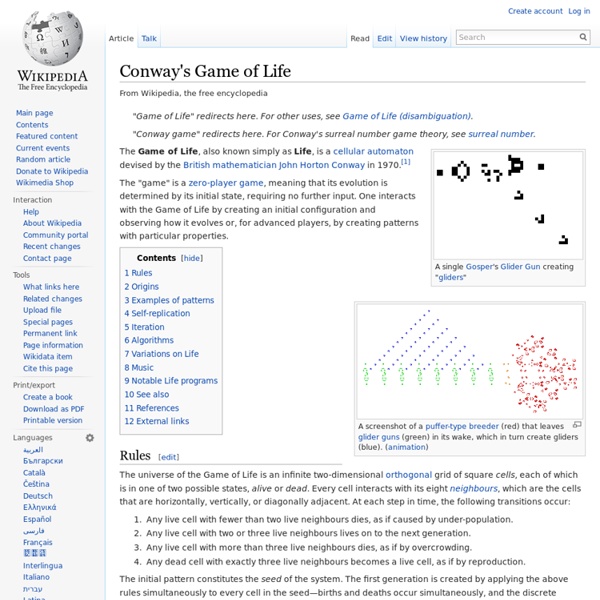Building Cross-Platform Apps Using jQuery Mobile
jQuery Mobile introduces a cross-platform and cross-device framework for developing mobile applications. It supports a wide variety of mobile browsers and delivers a unified user interface to the devices. It has simplified working with mobile browsers by abstracting away inconsistences between the vendors. Just as jQuery changed the way we wrote JavaScript , jQuery Mobile will change the way we build mobile web applications. I recently used jQuery Mobile to build an application and was stunned at how smoothly the development process went.
2048
Join the numbers and get to the 2048 tile! New Game How to play: Use your arrow keys to move the tiles. When two tiles with the same number touch, they merge into one! Note: The game on this site is the original version of 2048. Apps for iOS and Android are also available.
Existence
First published Wed Oct 10, 2012 Existence raises deep and important problems in metaphysics, philosophy of language, and philosophical logic. Many of the issues can be organized around the following two questions: Is existence a property of individuals? and Assuming that existence is a property of individuals, are there individuals that lack it?
Java Tutorial 7 - String Manipulation
String manipulation forms the basis of many algorithms and utilities such as text analysis, input validation, and file conversion. This tutorial explores some of the needed basics. Unless otherwise noted, the following classes are contained in the java.lang library. NOTE: For the following parameters the prefix g indicates string, i indicates integer and c indicates character types. The String Class
Etoile sauvage - Générateur de mandalas - applets - lesmandalas
Catégorie parente: Activites Catégorie : Applications en ligne Créé le jeudi 26 avril 2007 20:36
What makes a hero? - Matthew Winkler
The Hero Archetype in Literature, Religion, and Popular Culture: (along with a useful PowerPoint presentation teachers can download at this URL: ) Maricopa Center for Learning and Instruction (users embark on their own hero's journey): An American Masters Lesson from PBS for Teachers on George Lucas, the Power of Myth, and the Hero's Journey: And an interactive approach to the Hero's Journey: And of course, information about Joseph Campbell's works on the subject, on the Joseph Campbell Foundation site: The Hero With A Thousand Faces
CoRR - Computing Research Repository
Welcome to the Computing Research Repository Welcome to the Computing Research Repository (CoRR). CoRR allows researchers to search, browse and download papers through its online repository.
Logical Paradoxes » The Barber Paradox
The Barber paradox is attributed to the British philosopher Bertrand Russell. It highlights a fundamental problem in mathematics, exposing an inconsistency in the basic principles on which mathematics is founded. The barber paradox asks us to consider the following situation: In a village, the barber shaves everyone who does not shave himself, but no one else. The question that prompts the paradox is this: Who shaves the barber?
The Anagram Dictionary
t h e a n a g r a m d i c t i o n a r y
How to recognise a good programmer
It’s not as easy as it sounds. CV experience is only of limited use here, because great programmers don’t always have the “official” experience to demonstrate that they’re great. In fact, a lot of that CV experience can be misleading. Yet there are a number of subtle cues that you can get, even from the CV, to figure out whether someone’s a great programmer.
5 So-Called Signs of Genius That Any Idiot Can Learn
#2. Do Complicated Math Off the Top of Your Head Getty
21 Laws of Computer Programming
Jun 17 As any experienced computer programmer knows, there are unwritten laws that govern software development. However there are no penalties for breaking these laws; rather, there is often a reward.
The World As I See It - StumbleUpon
"How strange is the lot of us mortals! Each of us is here for a brief sojourn; for what purpose he knows not, though he sometimes thinks he senses it. But without deeper reflection one knows from daily life that one exists for other people -- first of all for those upon whose smiles and well-being our own happiness is wholly dependent, and then for the many, unknown to us, to whose destinies we are bound by the ties of sympathy. A hundred times every day I remind myself that my inner and outer life are based on the labors of other men, living and dead, and that I must exert myself in order to give in the same measure as I have received and am still receiving...
Top 10 Ways to be Screwed by "C"
To get on this list, a bug has to be able to cause at least half a day of futile head scratching, and has to be aggravated by the poor design of the "C" language. In the interests of equal time, and to see how the world has progressed in the 20-odd years since "C" escaped from its spawning ground, see my Top 10 Ways to be Screwed by the Java programming language, and for more general ways to waste a lot of time due to bad software, try my Adventures in Hell page. A better language would allow fallible programmers to be more productive. Infallible programmers, of the type unix' and "C" designers anticipated, need read no further.



